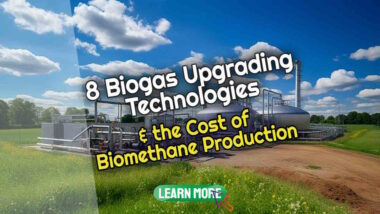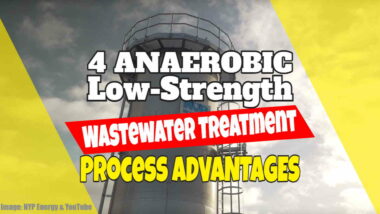Welcome to our in-depth explanation of the municipal wastewater sludge digestion process which is used at Activated Sludge Aeration WwTWs which now means the vast majority of global WwTWs.
In modern times, wastewater treatment plants (WWTPs) have become increasingly sophisticated in their approach to waste management. One of the most important processes within any WWTP is the digestion of municipal wastewater sludge. Extended aeration WWTPs (EA-WWTPs) are the most common type of facility, and possibly the only one in significant numbers, that utilizes this process.
The proportion of biogas produced during the sludge digestion process which is not sacrificed to the running of the plant itself is low compared with agricultural Ad plants, is comparatively low. However, there is a big advantage in the fact that the organic source used is usually available for free.
Why the wastewater sludge digestion process is so important
The wastewater sludge digestion process is a crucial step in the treatment and management of wastewater, as it allows for the safe and efficient disposal of organic waste.
At its core, the municipal wastewater sludge digestion process is a biological process that allows for the conversion of organic matter into biogas, water, and solids. This process can be broken down into two primary stages:
- the anaerobic sludge digestion stage and the
- aerobic digestion stage.
During the anaerobic digestion stage, microorganisms consume organic matter in the absence of oxygen, resulting in the formation of biogas. The aerobic digestion stage (better known as composting) then provides further removal of organic matter, along with the stabilization of the remaining sludge.
Overall, the municipal wastewater sludge digestion process is a critical aspect of any Municipal WWTP.

Environmentally Sound and Sustainable Sludge Treatment
By breaking down organic waste into biogas and other harmless byproducts, WWTPs can ensure that they are operating in an environmentally sound and sustainable manner.
Additionally, this process allows for the efficient management of waste, which helps to minimize costs and maximize the overall efficiency of the facility.
The big win-win for the sludge digestion process occurs when the water utility company digests their sludge via co-disposal with large quantities of higher calorific value organic wastes. Biogas output per unit volume goes up a lot, and the process will usually operate better (be more stable and make a higher percentage of methane) with the careful addition of other biowastes.
Understanding Anaerobic Sludge Stabilization: The Biological Process of Sludge Digestion Applied to Sludge from Aeration of Activated Sludge
Anaerobic sludge stabilization is a biological process that is carried out to digest sludge from the aeration of activated sludge. This process is essential in the treatment of wastewater as it helps to stabilize the sludge before it can be disposed of. Once stabilized, the sludge can be used as fertilizer in many instances and the impact it causes can be positive rather than polluting and negative.
During the sludge digestion process, microorganisms break down the organic matter in the sludge in the absence of oxygen. This process results in the production of biogas which can be used to generate heat and electricity and also reduces the amount of solid waste generated.
The Process needs to be monitored and controlled in order to acheive a high efficiency
It is important to understand the anaerobic sludge stabilization process to ensure that the wastewater treatment plant is running efficiently and will continue to do so.
By monitoring the sludge digestion process, plant operators can determine the optimal operating conditions for the system and make necessary adjustments to ensure that the sludge is digested completely. This process also helps to reduce the environmental impact of sludge disposal, as it reduces the amount of solid waste that must be disposed of, and helps to minimize greenhouse gas emissions.
Understanding the anaerobic sludge stabilization process is crucial for effective wastewater treatment. By optimizing the process and minimizing the environmental impact of sludge disposal, wastewater treatment plants can operate efficiently and sustainably.
Understanding the Biological Processes of Sludge Stabilization through Digestion
Sludge stabilization through digestion is a crucial process in wastewater treatment plants, and understanding the underlying biological processes is essential for ensuring the efficiency and sustainability of the treatment process.
As we have already highlighted the sludge digestion process occurs through two primary mechanisms: anaerobic digestion and aerobic digestion.
Anaerobic digestion is a process in which microorganisms break down organic matter in the absence of oxygen, resulting in the production of biogas and stabilized sludge.
On the other hand, aerobic digestion utilizes oxygen to break down organic matter, producing carbon dioxide and water.
To understand the biological processes involved in sludge stabilization through digestion, it is essential to examine the microbial communities responsible for the sludge digestion process.
Microbial communities responsible for sludge digestion
In anaerobic digestion, a combination of acid-forming and methanogenic bacteria is responsible for breaking down the organic matter. The acid-forming bacteria convert the complex organic matter into volatile fatty acids, which are then utilized by methanogenic bacteria to produce methane gas.
In contrast, aerobic digestion is dependent on a range of microorganisms, including bacteria, fungi, and protozoa, that work together to break down the organic matter through oxidation.
Overall, understanding the biological processes involved in sludge stabilization through digestion is essential for maintaining efficient and safe wastewater treatment.
By gaining a deeper understanding of the microbial communities that drive these processes, wastewater treatment plants can optimize their treatment strategies, improve treatment efficiency, and reduce their environmental impact.
Alternative Methods of Sludge Stabilisation
Alternative Methods of Sludge Stabilisation are becoming increasingly popular due to their effectiveness in treating wastewater and reducing the environmental impact of traditional methods. The use of the alternative method has become a viable option for many treatment plants, as they offer numerous benefits, including lower costs, improved sludge quality, and reduced energy consumption.
Anaerobic digestion
The most popular sludge digestion process which has recently become mainstream is anaerobic digestion, which is a process that utilises bacteria to break down organic matter in the absence of oxygen, resulting in the production of biogas. This biogas can then be used to generate electricity, providing an important source of renewable energy.
Composting
Another effective alternative is composting, which involves the decomposition of organic matter by microorganisms under controlled conditions to produce a nutrient-rich material that can be used as a soil amendment.
Historic incineration
Until 20 years or so ago, the preferred method of sludge treatment was incineration, but new sludge incineration plants are no longer built due largely to the high cost of the natural gas used to accomplish incineration. However, the issues around achieving Net-Zero in 2050 now also have a large bearing on incineration use.
This sludge digestion process is particularly useful for biosolids, which are a by-product of wastewater treatment containing high levels of nutrients that can promote plant growth.
Thermal treatment – pyrolysis and gasification
Other innovative methods include thermal treatment, such as pyrolysis and gasification, which can convert sludge into useful products such as biochar and syngas.
Overall, of all these alternative sludge digestion process methods anaerobic digestion provides the more sustainable and cost-effective approach to sludge stabilisation, contributing to a more environmentally conscious and efficient wastewater treatment process.
Anaerobic Digestion: The Popular Choice for Sludge Stabilization
Anaerobic digestion has gained popularity as a reliable and efficient method for sludge stabilization. This technique involves the breakdown of organic matter in the absence of oxygen by microorganisms, resulting in the production of:
- biogas and a stable,
- nutrient-rich material (digestate) that can be used as a natural fertiliser and soil conditioner.
The process offers numerous advantages, including:
- the reduction of volume and mass of the sludge,
- destruction of pathogens and harmful organisms, and the
- generation of renewable energy.
The anaerobic sludge digestion process is particularly useful for treating high-strength sludge, such as that produced by industrial processes, as it can handle a wide range of organic materials and achieve high levels of stabilization.
The biogas produced during the process can be used as a source of heat and electricity, thus providing a sustainable and cost-effective solution for wastewater treatment facilities.
Additionally, using anaerobic digestion for sludge stabilization helps to reduce greenhouse gas emissions, as the process captures and converts methane – a potent GHG – into a useful energy source.
Overall, anaerobic digestion (used as the sludge digestion process) offers a proven and popular choice for sludge stabilization, providing numerous benefits for both wastewater treatment operators and the environment.
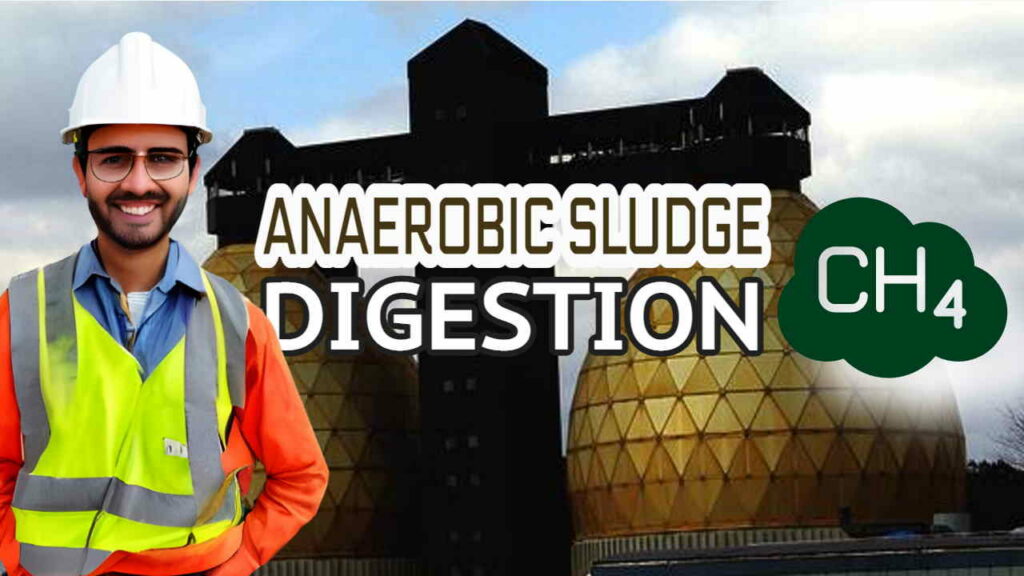
Sludge Conditioning
Dewatering in the Digestion Process
Sludge conditioning plays a crucial role in the wastewater treatment process, specifically in the sludge digestion process. The digestion process involves the breaking down of organic solids in wastewater to produce biogas, a renewable source of energy.
However, before the sewage sludge can undergo the digestion process, it needs to be dewatered. Dewatering is the process of removing excess water from solids to reduce their volume and weight.
Improved dewatering efficiency can bring numerous benefits to wastewater treatment plants, such as reducing operating costs, decreasing the volume of treated sludge, and enhancing biogas production. To achieve these benefits at a still higher level, sludge conditioning is necessary.
Sludge conditioning
Sludge conditioning involves adding chemicals to the sludge to enhance its dewatering properties.
The type and quantity of conditioning chemicals used depend on the characteristics of the sludge, such as its solids content, pH, and composition. Commonly used sludge conditioning chemicals include:
- coagulants,
- flocculants, and
- polymers.
These chemicals help to agglomerate the solids in the sludge, making them easier to dewater.
Additionally, they also improve the settling properties, reduce clogging of the dewatering equipment, and improve dewatering performance.
Thus, effective sludge conditioning is essential for improving dewatering efficiency, reducing operational costs, and increasing revenue from biogas production.
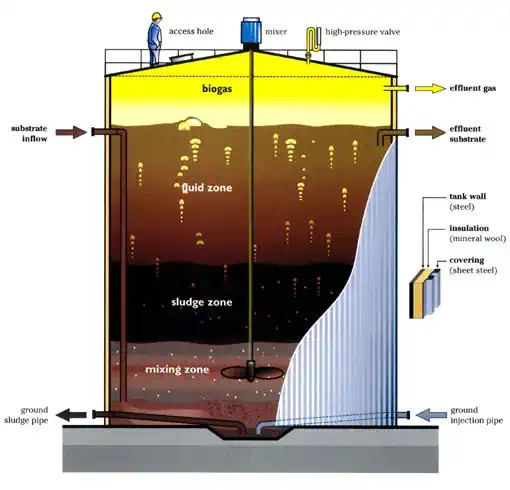
The 4 Process Steps of Anaerobic digestion process for sludge treatment and energy generation.
As already established, anaerobic digestion process is an effective method for sludge treatment and energy generation.
It involves four distinct process steps that break down organic material in an oxygen-free environment.
Step 1 – Hydrolysis
The first step is hydrolysis, where soluble organic compounds are converted into smaller molecules by enzymes. This makes it easier for microorganisms to digest the organic material in the next step.
Step 2 – Acidogenesis
The second step is acidogenesis, where bacteria convert smaller molecules into organic acids such as acetic acid, propionic acid, and butyric acid.
Step 3 – Acetogenesis
The third step is acetogenesis, where acetogenic bacteria convert organic acids into acetic acid and hydrogen gas.
Step 4 – Methanogenesis
Finally, the fourth step is methanogenesis, where methanogenic bacteria convert acetic acid and hydrogen gas into methane and carbon dioxide.
The anaerobic digestion process is beneficial for sludge treatment and energy generation as it reduces the amount of waste material, produces biogas that can be used for energy, and lowers greenhouse gas emissions.
The process can be used in various sectors such as wastewater treatment plants, agricultural operations, and food processing facilities.
To ensure the efficiency of the process, it is important to maintain the ideal temperature, pH, and mixing conditions. In addition, proper maintenance and monitoring are essential to prevent the accumulation of toxic compounds or other factors that may interfere with the process.
The proper implementation of the four process steps of anaerobic digestion process can lead to an efficient and sustainable method for sludge treatment and energy generation.
Efficient Sludge Thickening for Effective Anaerobic Digestion
The choice of the most suitable thickening method depends on the characteristics of the sludge, the required solids concentration, and the available resources. Efficient sludge thickening requires careful selection of the equipment, control of the operating parameters, and timely maintenance.
Improper operation and maintenance can lead to clogging, foaming, and poor thickening performance, resulting in a significant decrease in efficiency and increased operational costs.
Therefore, it is essential to implement good operational and maintenance practices to ensure the longevity and reliability of the equipment. In conclusion, efficient sludge thickening is a critical process that has a significant impact on the effectiveness of anaerobic digestion.
Proper thickening can reduce the cost of handling and transportation, increase biogas production, and improve the quality of biosolids. Careful selection of the thickening method, along with good operational and maintenance practices, can ensure optimal thickening performance.
Sludge Digestion Converts Organic Matter to Biogas and Reduces Content by 40-50%
Sludge digestion is a highly effective wastewater treatment process that utilizes microbes to break down organic matter in sludge, resulting in the production of biogas and a significant reduction in sludge content by 40-50%.
This process has gained popularity among industries and municipalities due to its efficient and cost-effective nature. During the digestion process, the organic matter in the sludge is broken down into simpler compounds by microbial activity.
The microbes consume the organic matter and convert it into biogas – a mixture of methane and carbon dioxide – which can be used as an energy source. Moreover, the digestion process significantly reduces the volume of sludge, making it easier and more cost-effective to dispose of.
The remaining sludge is less odorous, easier to handle, and has far fewer pathogens. Sludge digestion has numerous environmental benefits as well, as it promotes the sustainable use of resources.
The biogas produced from the process can be used as fuel for heating, electricity generation, and transportation, thereby reducing greenhouse gas emissions and dependence on non-renewable energy sources.
In conclusion, the sludge digestion process is an essential component of wastewater treatment, providing an efficient and sustainable method for waste management while also promoting environmental sustainability.
Its benefits make it a crucial tool for industries and municipalities to reduce their environmental impact and move towards more sustainable practices.
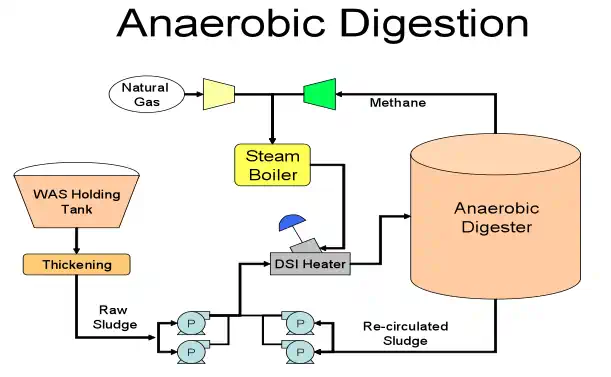
Pretreatment of Sludge for efficient Anaerobic Digestion
Pretreatment of sludge is an essential process for efficient anaerobic digestion. Sludge is a by-product of the wastewater treatment process, and it contains high levels of organic matter and nutrients.
Anaerobic digestion is an effective way to treat sludge and convert it into biogas, which can be used as a renewable energy source. However, untreated sludge can be challenging to digest due to its high viscosity, low biodegradability, and low nutrient availability.
Thermal hydrolysis
Therefore, pretreatment methods are necessary to improve the efficiency of anaerobic digestion. One of the most common pretreatment methods is thermal hydrolysis, which involves heating the sludge to high temperatures and pressures. This process breaks down the complex organic compounds in the sludge into simpler compounds that are more easily digestible.
Chemical Pretreatment
Another pretreatment method is the addition of chemical agents such as acids, bases, and oxidants. These agents help to break down the organic matter in the sludge and improve its biodegradability.
Mechanical pretreatment
Mechanical pretreatments, such as grinding and homogenization, can also be effective in reducing the particle size of sludge and increasing its surface area, which improves the accessibility of microorganisms and enzymes.
In conclusion to this section, the pretreatment of sludge is crucial for efficient anaerobic digestion. Pretreatment methods such as thermal hydrolysis, chemical agents, and mechanical treatment can significantly improve the biodegradability and digestibility of sludge.
Adoption of these pretreatment methods can lead to more efficient wastewater treatment, reduction in waste volume, and production of biogas as a valuable renewable energy source.
Comparison of Low Rate and High Rate Sludge Digestion Processes
As we have already established, sludge digestion is an essential process in wastewater treatment plants as it helps to stabilize the sludge and reduce its volume.
The two most common methods of sludge digestion are low-rate and high-rate processes.
Low-rate digestion
The low-rate digestion process is a traditional method that involves the anaerobic digestion of sludge in a tank for an extended period, usually between 20 and 40 days. On the other hand, high-rate digestion is a modern technique that involves the use of an anaerobic reactor with a high organic loading rate.
High rate digestion
This process takes a shorter time, usually between 5 and 15 days.
The high-rate process is faster, and as such, it is more efficient in reducing the sludge volume and stabilizing the sludge. However, it requires a higher level of expertise and management to maintain optimal operating conditions.
High and Low Rate AD Compared
The low-rate process, while slower, is simpler and easier to operate, making it a popular option for small-scale facilities. Another significant difference between these two processes is the level of biogas production.
High-rate digestion produces a higher quantity of biogas than the low-rate process, making it more economically sustainable in terms of energy recovery. The low-rate process, however, produces a stable, consistent level of biogas that may be more appropriate for small-scale facilities or those with limited resources.
In conclusion, each sludge digestion method has its advantages and disadvantages, and selection is dependent on several factors, including:
- the plant size, energy demand, and
- available resources.
An informed decision should be made based on the specific needs of the wastewater treatment plant.
Dual Stage Digestion: A Faster and More Efficient Sludge Digestion Process
Dual Stage Digestion is a technology that has revolutionized the sludge digestion process, making it faster, more efficient, and cost-effective.
Single-stage digestion is a simple and efficient process that involves anaerobic digestion of primary and secondary sludge in one tank, which results in the production of biogas. This process is ideal for smaller treatment plants as it requires minimal capital investment and is easy to operate. But, for larger WwTWs a two-stage sludge digestion process is better.
This process involves two stages;
The first stage of digestion involves hydrolysis, where the sludge is broken down into smaller molecules by enzymes and bacteria. This is followed by the second stage, where the sludge is further processed by anaerobic digestion, which converts the hydrolyzed sludge into biogas and a nutrient-rich liquid fertilizer.
The second stage is the anaerobic digestion stage of acidogenesis and methanogenesis. In the acidogenesis stage, organic matter is broken down into volatile fatty acids (VFAs) through the action of acidogenic bacteria. These VFAs are then converted into biogas in the methanogenesis stage through the activity of methanogenic bacteria.
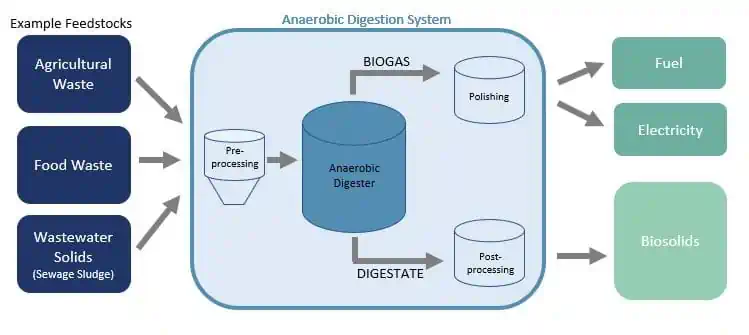
The use of dual-stage digestion has several advantages over the traditional single-stage digestion process.
Firstly, it improves digestion efficiency by increasing the organic loading rate and reducing hydraulic retention time. This means that more sludge can be treated in a shorter time, reducing operational costs and increasing productivity.
Secondly, the dual-stage process produces more biogas, which can be utilized as a renewable energy source, reducing fossil fuel consumption.
In addition to these benefits, Dual Stage Digestion also has a positive impact on the environment. By producing biogas and reducing the amount of sludge disposed of in landfills, this process helps to reduce greenhouse gas emissions and mitigate climate change.
Overall, the Dual Stage Digestion process is an innovative, sustainable, and efficient solution for sludge digestion that offers several benefits for wastewater treatment plants.
Its adoption can help to enhance the performance of wastewater treatment plants, reduce operational costs, and promote environmental sustainability.
Aerobic Digestion: Microbial Self-Sustenance for Sludge Digestion
The anaerobic digestion process is highly efficient and sustainable, as it harnesses the natural power of aerobic microorganisms to degrade the organic components in sludge, converting them into carbon dioxide, water, and biomass. The process requires a carefully controlled environment that provides optimal conditions for the microbial community to thrive and carry out its digestive function.
This includes maintaining proper levels of oxygen, nutrients, and pH levels within the aerobic digester.
The end result of this process is a significant reduction in the quantity of sludge produced, as well as a reduction in the amount of biosolids that need to be disposed of.
Additionally, the process also generates energy in the form of biogas, which can be used to power generators or sold back to the grid, making it a highly sustainable and economically viable solution.
With increased emphasis on sustainability and environmentally friendly practices, aerobic digestion has quickly become the favoured technology for wastewater treatment plants.
Its ability to effectively reduce sludge volume while generating energy makes it a valuable asset for organizations looking to reduce their environmental impact and improve their bottom line.

Sludge Digestion: Understanding the Oxidation and Biodegradation of Cell Components
In sludge digestion, the organic matter undergoes a series of complex biochemical reactions, facilitated by microbes, that convert it into simpler substances and ultimately biogas. The oxidation and biodegradation of cell components, such as proteins, carbohydrates, and lipids, play a critical role in this process.
Proteins are broken down into amino acids, which are then converted into ammonia or volatile fatty acids (VFAs) through microbial activity.
Carbohydrates are converted into VFAs and carbon dioxide through fermentation, while lipids are hydrolyzed into fatty acids and glycerol. These VFAs, along with other intermediate compounds such as acetic acid and methane, are further broken down to produce biogas.
Understanding the oxidation and biodegradation of cell components is important in optimizing the operating conditions of the sludge digestion process. This includes factors such as temperature, pH, and the type of microbes present.
By better understanding these factors, wastewater treatment plants can increase the efficiency of sludge digestion, reduce the amount of waste produced, and generate more renewable energy. Ultimately, the use of sludge digestion plays a critical role in sustainable wastewater treatment
Aerobic Digestion of Biomass in Sludge: Nitrogen Conversion and Nitrification Processes Explained
Aerobic digestion of biomass in sludge is a complex process involving a series of crucial reactions. This process is widely used in wastewater treatment facilities to treat and dispose of biosolids. One of the key reactions that take place during aerobic digestion is nitrogen conversion.
During this process, nitrogen in the sludge is transformed into various forms such as nitrate, ammonia, and organic nitrogen compounds. The conversion of nitrogen is a critical step in the sludge digestion process as it plays a significant role in the removal of harmful pollutants from wastewater sludge.
Another process that occurs during aerobic digestion is nitrification. Nitrification is the biological conversion of ammonia to nitrate. This process is carried out by two groups of microorganisms, namely ammonium-oxidizing bacteria and nitrite-oxidizing bacteria. The process of nitrification is crucial in the wastewater treatment process as it helps to convert toxic ammonia into less harmful nitrate.
Overall, the aerobic digestion of biomass in sludge is a complex and critical process in the treatment of wastewater. Understanding the nitrogen conversion and nitrification processes involved is essential to ensure efficient and effective treatment of wastewater and the safe disposal of biosolids.
It is crucial to have skilled professionals with the knowledge and expertise to design and operate wastewater treatment facilities to produce high-quality effluent and biosolids that meet environmental and regulatory standards.
Anaerobic Sludge Digestion: A Costly Yet Effective Process for Wastewater Treatment Facilities
Despite the initial capital investment required for anaerobic digestion, it can result in significant long-term cost savings for wastewater treatment facilities. The biogas generated during the process can be used to generate electricity or heat, reducing energy costs.
Moreover, the reduction in sludge volume means fewer resources are required for disposal, further reducing costs.
Anaerobic digestion also produces a nutrient-rich fertilizer that can be used in agriculture, further reducing environmental impact and adding value to the process.
Overall, anaerobic sludge digestion offers a sustainable and cost-effective method for wastewater treatment facilities to manage their waste.
Comparison of the Anaerobic and Aerobic Sludge Digestion Process in Sludge Treatment
Anaerobic digestion is more suitable for sludge with a high organic content than aerobic treatment. In contrast, aerobic digestion is better suited for fresh effluents with lower organic contents.
However, aerobic digestion has several benefits over anaerobic digestion.
Aerobic digestion is a faster process, resulting in a shorter retention time.
Both anaerobic and aerobic digestion processes have their advantages and disadvantages, and the choice between the two should be based on the specific needs of the wastewater treatment plant. Factors such as the organic content of the sludge, energy requirements, and odour control should be considered when deciding which method to use.
Understanding the Differences Between Thickened and Dewatered Sludge for Digestion Processes.
In the wastewater treatment process, the production of sludge is inevitable, and it needs to be treated to prevent environmental hazards. Two common methods of treating sludge are thickening and dewatering.
However, there are significant differences between these two methods, especially concerning their effectiveness in digestion processes. Understanding the differences between thickened and dewatered sludge is essential in ensuring the proper treatment of sludge.
The thickened sludge is a high-solid-content material that is less fluid than dewatered sludge. It is produced by removing some of the water content through gravity settling, centrifugation, or dissolved air flotation. In contrast, dewatered sludge is a dry material that has undergone extensive water removal through mechanical dewatering techniques such as centrifugation, belt press, or filter presses.
Both thickened and dewatered sludge can be used in digestion processes, but their differences play a crucial role in their effectiveness. Dewatered sludge has significantly lower water content, making it easier to transport and store, and its higher solids content allows for greater biogas production during digestion.
Conversely, thickened sludge has lower dewatering costs and requires less polymer, making it a more cost-effective option. In conclusion, there are significant differences between thickened and dewatered sludge, especially concerning their effectiveness in digestion processes.
Understanding the differences between these two methods is essential in deciding which method is more appropriate for a particular wastewater treatment plant. By choosing the appropriate sludge treatment method, it is possible to improve efficiency, reduce costs, and minimize environmental hazards in the wastewater treatment process.
Conclusion to: The Sludge Digestion Process from Conditioning to Dewatering and Disposal
In conclusion, the process of sludge digestion involves multiple stages, from conditioning to dewatering and disposal, that are all essential for the effective management of wastewater treatment plants.
Conditioning serves to enhance the sludge's susceptibility to anaerobic digestion, which is the primary method of sludge stabilization. During this process, microorganisms convert the organic matter in the sludge into biogas, an energy source that can be used to power the plant or fed into the grid.
Dewatering, on the other hand, is crucial in the reduction of the sludge volume, making it easier and more cost-effective to transport and dispose of. Advanced dewatering techniques, such as centrifugation, provide high solids recovery and produce sludge cake with low water content, which is easier to handle and dispose of.
Finally, the disposal of the sludge is a critical aspect of the entire sludge digestion process. The effective and safe disposal of the sludge takes into account regulatory frameworks, environmental considerations, and the most appropriate disposal method.
Common alternative methods to the sludge digestion process include land application of raw sludge, landfill disposal, and incineration.
Ultimately, the success of the sludge digestion process, from conditioning to dewatering to disposal, is contingent upon effective monitoring and management, which ensures that the process is safe, efficient, and meets the desired outcomes.
Overall, effective management of sludge digestion is crucial for wastewater treatment plants, as it ensures responsible and the most sustainable disposal helping to protect the environment and public health.

